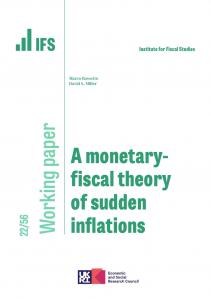This article was first printed by the Times and has been reproduced here in full with permission.
I don’t like to make predictions. But here are two. First, if Labour win the next election they will not, contrary to last week’s claims by the Conservatives, increase planned public spending in 2015-16 by anything like £20 billion. Second, if the Conservatives win the election they will neither, despite what the opposition would have us believe, destroy the NHS nor return the welfare state to some Dickensian, or at least 1930s, level of provision.
These hyperbolic claims are of course just part of normal pre-election rhetoric. At one level they are nonsense. But the competing claims do tell us something. This time around the stated fiscal positions of Labour and Conservatives are really very different. More different than at any election since at least 1992, and arguably since 1983.
Suppose we look at what each party has said about their own aspirations, rather than at what they have said about each other. If we take their statements at face value then by 2020 an Ed Miliband led government would be borrowing and spending a lot more than a David Cameron led government. Conversely a Cameron led government would have implemented much more severe spending cuts than would one led by Miliband.
Labour have said they want to achieve balance or surplus on the current budget. That is they would be happy to keep borrowing to pay for investment spending. At current levels of investment spending that would allow them to borrow around £25 billion a year. To achieve that they would need to find spending cuts, or tax increases, of around £7 billion after 2015-16. Perhaps not easy after so many years of austerity – and don’t forget both parties are signed up to a tough spending round in 2015-16 itself – but cuts of this magnitude over the rest of the parliament would be modest relative to what has been delivered thus far.
The Conservative plans are rather different. They want to achieve a surplus on the overall budget and so would not be happy to borrow to invest. That means they would need to find spending cuts of around £33 billion after 2015-16. Lest there be any doubt, there is a big difference between £7 billion of cuts and £33 billion of cuts.
In fact the difference between the parties may even greater than that. If you take the plans set out in the Autumn Statement at face value spending cuts of more than £50 billion could be required after 2015-16. It was this apparent ambition that led the Office for Budget Responsibility to warn that spending on public services could fall to its lowest level since the 1930s.
One thing all the parties seem to agree on though is that spending on health, schools and pensions should be protected. But these are the biggest bits of spending. If these protections are continued the scale of Labour/Conservative differences can be seen particularly starkly. Under Autumn Statement plans Conservatives could be cutting unprotected budgets by 26% after 2015-16, or an extraordinary 41% over the whole period from 2010. Even just to meet their more modest fiscal target these budgets would need to be cut by more than 15% after 2015-16. Labour would need to implement cuts of just 3%.
All of this of course points to another big difference. If Labour is spending more – and if it doesn’t raise taxes – it will be borrowing more and perhaps more importantly presiding over a greater burden of debt. The effect of this might be relatively modest in the short term, but borrowing as much as their rule would allow beyond 2020 would mean national debt around £170 billion higher (in today’s terms) by the end of the 2020s than would be achieved through a balanced budget. So even if Labour do keep spending cuts to a minimum over the next parliament, further tax increases or spending cuts might prove necessary down the line in order to reduce risks with the long term state of the public finances further. The problem is that another recession will strike one day. Going in to a new recession with debt still high – and it’s higher now than at any time since the late 1960s could leave less room for manoeuvre. The sort of additional borrowing that we were able to support as we made our way through the recent period might not be as easily financed.
So the choices are pretty stark. The Conservatives offer some more dramatic spending cuts, which may not prove easy to deliver. Under their plans we are not even half way through the cuts. Labour offer an easier (but not easy) time for public services, but probably more risk with the public finances. One thing they do have in common is an unwillingness to discuss the third leg of the fiscal stool – taxes. But don’t let it be said that the two main parties offer no choice at this election. These are real, meaty political choices.







